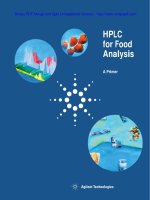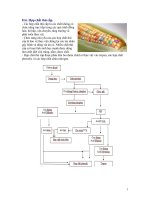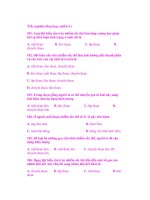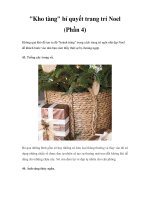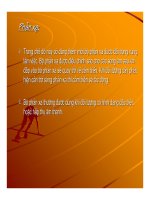HPLC for Food Analysis phần 4 ppsx
Bạn đang xem bản rút gọn của tài liệu. Xem và tải ngay bản đầy đủ của tài liệu tại đây (273.25 KB, 14 trang )
Chapter 3
Analytical
examples of
natural
components
Inorganic anions
Anions containing halogen, nitrogen, and sulfur are used as
additives in food industries. For example, nitrites act as
preservatives in smoked sausage. Nowadays, dedicated
instrumentation such as special columns and electro-
conductivity detectors are used in the analysis of inorganic
anions. Because specialized equipment has a very limited
application range, a method was developed for analyzing
anionsusing reversed-phase chromatography and indirect
UV detection. Another, more selective and sensitive
approach for the analysis of selected anions is electro-
chemical detection.
Sample preparation
Excepting filtration, sample preparation normally is
unnecessary if the sample is aqueous. Other matrices
can be extracted with hot water, followed by filtration.
32
3
Auto-
sampler
Isocratic
pump +
vacuum
degasser
Control and
data evaluation
Water/ACN
Column
compart-
ment
Auto-
sampler
Variable
wave-
length
detector
33
Sample preparation filtration
Column HP-IC (modifiers for the
mobile phase are
included)
Mobile phase water/acetonitrile (ACN)
(86:14), adjusted to
pH = 8.6 with
carbonate-free NaOH
Flow rate 1.5 ml/min
Oven temperature 40 ºC
Injection volume 25 µl
Detector UV-VWD
detection wavelength
266 nm
Chromatographic conditions
The HPLC method presented here was used for the analysis
of anions in drinking water.
Figure 23
Analysis of anions in drinking water with indirect UV-detection
HPLC method performance
Limit of detection
for UV-VWD 0.1–1 ppb with S/N = 2
and 25 µl injected
volume
Repeatability of
RT over 10 runs < 0.8 %
areas over 10 runs < 1 %
Time [min]
246810
mAU
-20
0
20
40
60
80
100
Standard
Drinking water
F
Cl
Br
H PO
Cl = 15 ppm
NO = 0.9 ppm
3
NO
2
4
SO = 40 ppm
4
SO
4
NO
3
HCO
3
-
-
-
-
-
-
-
2
2
-
-
-
2
-
2
Sample preparation Table salt was dissolved
in water.
Column 200
x 4 mm
Sperisorb ODS2, 5 µm
Mobile phase water with 5.2 g/l
K
2
HPO
4
+ 3 g/l
tetrabutylammoniumdi-
hydrogenphosphat/ACN
(85:15)
Flow rate 1 ml/min
Oven temperature ambient 24 ºC
Injection volume 0.1 µl
Detector electrochemical (ECD)
Electrode: glassy carbon,
Working potential: 1 V
Operation mode: amperometry
Chromographic conditions for electrochemical detection
The HPLC method presented here was used for the
analysis of iodide in table salt.
17
34
HPLC method performance
Limit of detection
for ECD 40 µg/l
Repeatability of
RT over 10 runs < 0.1 %
areas over 10 runs 3 %
Linearity min 50 pg to 150 ng
.
100
120
140
160
180
Table salt
2 4 6 8 10 12 14
I
-
Time [min]
Standard
mV
I
-
Figure 24
Analysis of iodide in table salt
17. A.G. Huesgen, R. Schuster, ”Analysis of selected anions with HPLC
and electrochemical detection”, Agilent Application Note 5091-1815E, 1991.
3
Auto-
sampler
Isocratic
pump +
vacuum
degasser
Control and
data evaluation
Water
Column
compart-
ment
Auto-
sampler
Electro-
chemical
detector
35
Lipids
Triglycerides and
hydroperoxides in oils
Both saturated and unsaturated triglycerides have been
analyzed. Fats and oils are complex mixtures of
triglycerides, sterols, and vitamins. The composition of
triglycerides is of great interest in food processing and
dietary control. Owing to the low stability of triglycerides
containing unsaturated fatty acids, reactions with light and
oxygen form hydroperoxides, which strongly influence the
taste and quality of fats and oils. Adulteration with foreign
fats and the use of triglycerides that have been modified by
a hardening process also can be detected through
triglyceride analysis.
The HPLC method presented here was used to analyze
triglycerides, hydroperoxides, sterols, and vitamins with
UV-visible diode-array detection (UV-DAD). Spectra were
evaluated in order to trace hydroperoxides and to
differentiate saturated from unsaturated triglycerides.
Unsaturated triglycerides in olive oil have a very distinctive
pattern. Other fats and oils are also complex mixtures of
triglycerides but exhibit an entirely different pattern.
Adulteration with foreign fats and the use of refined
triglycerides in olive oil also can be detected through
triglyceride analysis.
Sample preparation
Triglycerides can be extracted from homogenized samples
with petrol ether. Fats and oils can be dissolved in
tetrahydrofuran.
17
Quaternary
pump +
vacuum
degasser
Control and
data evaluation
Water
Acetonitrile
Column
compart-
ment
Auto-
sampler
Diode-
array
detector
Sample preparation Samples were dissolved
in tetrahydrofuran (THF).
Column 200 x 2.1 mm
Hypersil MOS, 5 µm
Mobile phase A = water
B = ACN/methyl-
tert.butylether (9:1)
Gradient at 0 min 87 % B
at 25 min 100 % B
Post time 4 min
Flow rate 0.8 ml/min
Column compartment 60 ºC
Injection volume 1 µl standard
UV absorbance
200 nm and 215 nm to detect triglycerides
240 nm to detect hydroperoxides
280 nm to detect tocopherols and decom-
posed triglycerides (fatty acids with three
conjugated double bonds)
36
Time [min]
140
120
100
80
60
40
20
0
5
10
15 20
25
215 nm
240 nm
H
LLL
Absorbance [scaled]
00L
000
S00
PLL
ydroperoxides
*
*
*
*
*
*
*
Figure 25
Triglyceride pattern of aged sunflower oil. The increased response
at 240 nm indicates hydroperoxides
Good quality Poor quality
mAU
20
15
10
5
0
13.0 23.0
Time [min]
20
15
10
5
0
13.0 23.0
Time [min]
215 nm
280 nm
215 nm
280 nm
mAU
Olive oil
LLL
LL0
00L
000
S00
LL0
LL0
00L
000
S00
Figure 26
Analysis of olive oil. The response at 280 nm indicates a conjugated
double bond and therefore poor oil quality
3
HPLC method performance
Limit of detection
for saturated triglycerides > 10 µg
for unsaturated triglycerides
fatty acids with 1 double bond >150 ng
fatty acids with 2 double bonds > 25 ng
fatty acids with 3 double bonds < 10 ng
Repeatability of
RT over 10 runs < 0.7 %
areas over 10 runs < 6 %
37
Triglycerides in olive oil
Unsaturated triglycerides in olive oil have very characteris-
tic patterns. Other fats and oils are also complex mixtures
of triglycerides but with different patterns.
Sample preparation information
Triglycerides can be extracted from homogenized samples
with petrol ether. Fats and oils can be dissolved in
tetrahydrofurane.
Chromatographic conditions
The presented HPLC method was used to analyze the
unsaturated triglycerides, LnLnLn, LLL, and OOO.
18
Sample preparation Samples were dissolved
in tetrahydrofurane.
Column 200 × 2.1 mm
Hypersil MOS, 5 µm
Mobile phase acetone/ACN (30:70)
Flow rate 0.5 ml/min
Column compartment 30 ºC
Injection volume 2 µl
Detector refractive index
HPLC method performance
Limit of detection
for ECD 50 µg/l with S/N = 2
Repeatability of
RT over 10 runs < 0.3 %
areas over 10 runs 5 %
2
4
6
8
mV
40
60
80
100
120
140
160
180
200
Standard
Olive oil
Rape oil
Time [min]
LnLnLn
LLL
000
Figure 27
Analysis of the triglyceride pattern of olive and rape oil
18. “Determination of triglycerides in vegetable oils”,
EC Regulation No. L248, 28ff.
Auto-
sampler
Isocratic
pump +
vacuum
degasser
Control and
data evaluation
Acetronitrile
Column
compart-
ment
Auto-
sampler
Refractive
index
detector
Saturated and unsaturated fatty acids from C
4
through C
22
have been analyzed. Fatty acids are the primary compo-
nents of oils and fats and form a distinctive pattern in each
of these compounds. For example, butter and margarines
can be differentiated by the percentage of butyric acid in
the triglycerides. To determine the fatty acid pattern of a fat
or oil, free fatty acids first are obtained through hydrolysis.
Derivatization is then performed to introduce a chro-
mophore, which enables analysis of the fatty acids using
HPLC and UV-visible detection.
Sample preparation
The triglycerides were hydrolyzed using hot methanol and
KOH, followed by derivatization.
Chromatographic conditions
The HPLC method presented here was used in the analysis
of the fatty acid pattern of dietary fat. The method involves
hydrolysis with hot KOH/methanol and online derivatization
with bromophenacyl bromide.
38
3
Fatty acids
Quaternary
pump +
vacuum
degasser
Control and
data evaluation
Water
Acetonitrile
Column
compart-
ment
Auto-
sampler
Variable
wavelength
detector
39
C18-3
C18-2
C18-1
C14
C16
C18
C20
C22
1400
1000
600
200
mAU
15
20 25
30
Time [min]
Standard
Dietary fat
Standard
Figure 28
Analysis of a dietary fat triglyceride pattern. Overlay of one sample
and two standard chromatograms
Time [min]
20 22 24 26 28 30 32
Norm
0
10
20
30
40
VWD
DAD
C10, 9.9 ng
C12, 4.0 ng
C14, 3.0 ng
C16, 6.7 ng
C18, 4.5 ng
C20, 5.2 ng
C22, 3.3 ng
Figure 29
Trace analysis of triglycerides with a diode-array and a variable
wavelength detector in series
HPLC method performance
Limit of detection 200 pg injected amount,
S/N = 2
Repeatability of
RT over 10 runs < 0.1 %
areas over 10 runs 5 %
Sample preparation
0.215 g fat was hydrolyzed with 500 µl
MEOH/ KOH at 80 ºC for 40 min in a
thermomixer. After cooling 1.5 ml ACN/THF
(1:1) was added, and the mixture was shaken
for 5 min. The mixture was then filtered
through a 0.45-µm Minisart RNML from
Satorius.
Column 200
x 2.1 mm, MOS, 5 µm
Mobile phase A = water (70 %)
B = (ACN + 1 % THF)
(30 %)
Gradient at 5 min 30 % B
at 15 min 70 % B
at 17 min 70 % B
at 25 min 98 % B
Flow rate 0.3 ml/min
Column compartment 50 °C
Detector variable wavelength,
258 nm
Derivatization 60 mg/ml bromophenacyl
bromide was dissolved
in ACN.
Injector program for online derivatization
1. Draw 2.0 µl from vial 2 (ACN)
2. Draw 1.0 µl from air
3. Draw 1.0 µl from vial 3 (derivatization
agent)
4. Draw 0.0 µl from vial 4 (wash bottle)
(ACN/THF, 50:50)
5. Draw 1.0 µl from sample
6. Draw 0.0 µl from vial 4 (wash bottle)
7. Draw 1.0 µl from vial 3 (derivatization
agent)
8. Draw 0.0 µl from vial 4 (wash bottle)
9. Draw 1.0 µl from vial 5 (acetonitrile +
5 % TEA)
10. Draw 0.0 µl from vial 4 (wash bottle)
11. Mix 9 µl in air, 30 µl/min speed, 10 times
12. Wait 2.0 min
13. Inject
Carbohydrates
The following carbohydrates have been analyzed: glucose,
galactose, raffinose, fructose, mannitol, sorbitol, lactose,
maltose, cellobiose, and sucrose. Food carbohydrates are
characterized by a wide range of chemical reactivity and
molecular size. Because carbohydrates do not possess
chromophores or fluorophores, they cannot be detected
with UV-visible or fluorescence techniques. Nowadays,
however, refractive index detection can be used to detect
concentrations in the low parts per million (ppm) range and
above, whereas electrochemical detection is used in the
analysis of sugars in the low parts per billion (ppb) range.
Sample preparation
Degassed drinks can be injected directly after filtration.
More complex samples require more extensive treatment,
such as fat extraction and deproteination. Sample cleanup
to remove less polar impurities can be done through
solid-phase extraction on C18 columns.
40
3
Auto-
sampler
Isocratic
pump +
vacuum
degasser
Control and
data evaluation
Water
Column
compart-
ment
Auto-
sampler
Refractive
index
detector
4. Official Methods of Analysis, Food Compositions; Additives, Natuaral
Contaminants, 15th ed; AOAC: Arlington, VA, 1990, Vol. 2; AOAC Official
Method 980.13: Fructose, glucose, lactose, maltose, sucrose in milk chocolate;
AOAC Official Method 982.14: Glucose, fructose, sucrose, and maltose in
presweetened cereals; AOAC Official Method 977.20: Separation of sugars in
honey; AOAC Official Method 979.23: Saccharides (major) in corn syrup;
AOAC Official Method 983.22: Saccharides (minor) in corn syrup;
AOAC Official Method 984.14: Sugars in licorice extracts.
41
Norm
200
400
600
800
Standard
Lemonade
Raffinose
Citric acid?
Lactose
Glucose
Galactose
Fructose
510
15
Time [min]
Figure 30
Analysis of carbohydrates in lemonade
Time [min]
Lactose
5101520
Corn extract
Cellbiose Sucrose
Norm
80
100
120
140
160
180
Fructose
Glucose
Galactose
Raffinose
Maltose
Standard
Standard
Figure 31
Analysis of carbohydrates in corn extract
Chromatographic conditions
The HPLC method presented here was used to analyze
mono-, di-, and trisaccharides as well as sugar alcohols.
HPLC method performance
Limit of detection < 10 ng with S/N = 2
Repeatability of
RT over 10 runs < 0.05 %
areas over 10 runs 2 %
Sample preparation Samples were directly
injected.
Column 300 x 7.8 mm Bio-Rad
HPXP, 9 µm
Mobile phase water
Column compartment 80 ºC
Flow rate 0.7 ml/min
Detector refractive index
Vitamins
Fat-soluble vitamins, such as vitamins E, D, and A, and
water-soluble vitamins, such as vitamins C, B
6
, B
2
, B
1
, and
B
12
, have been analyzed.
Vitamins are biologically active compounds that act as
controlling agents for an organism’s normal health and
growth. The level of vitamins in food may be as low as a few
micrograms per 100 g. Vitamins often are accompanied by
an excess of compounds with similar chemical properties.
Thus not only quantification but also identification is
mandatory for the detection of vitamins in food. Vitamins
generally are labile compounds that should not exposed to
high temperatures, light, or oxygen. HPLC separates and
detects these compounds at room temperature and blocks
oxygen and light.
19
Through the use of spectral information,
UV-visible diode-array detection yields qualitative as well as
quantitative data. Another highly sensitive and selective
HPLC method for detecting vitamins is electrochemical
detection.
Sample preparation
Different food matrices require different extraction
procedures.
19
For simple matrices, such as vitamin tablets,
water-soluble vitamins can be extracted with water in an
ultrasonic bath after homogenization of the food sample.
42
Quaternary
pump +
vacuum
degasser
Control and
data evaluation
Water
Acetonitrile
Column
compart-
ment
Auto-
sampler
Diode-
array
detector
3
Water-soluble vitamins
Chromatographic conditions for UV detection
The HPLC method presented here was used to analysis
vitamins in a vitamin drink.
43
Sample preparation filtration
Column 100
x 4 mm
Hypersil BDS, 3 µm
Mobile phase A= water with pH = 2.1
(H
2
SO
4
) = 99 %
B = ACN 1 %
Gradient at 3.5 min 1 % B
at 11 min 25 % B
at 19 min 90 % B
Post time 6 min
Flow rate 0.5 ml/min
Column compartment 30 ºC
Injection volume 2–5 µl
Detector UV-DAD
detection wavelength
220/30 nm,
reference wavelength
400/100 nm
02
4
6
810
12
Norm
0
500
1000
1500
Citric acid
Standard
B1
B6
Pantothenic acid
B12
Biotin
Riboflavin
Folic acid, d
Vitamin
tablet
Saccharin
Time [min]
Vitamin C
Riboflavin 5'phos
HPLC method performance
Limit of detection < 500 pg (injected
amount), S/N = 2
Repeatability of
RT over 10 runs < 0.2 %
areas over 10 runs < 2 %
Figure 32
Analysis of water-soluble vitamins in a vitamin tablet
250 350
450
550
Norm
0
400
800
Riboflavin
250
350
450 550
Norm
200
600
1000
250 350 450 550
0
200
400
Folic acid
nm
nm
nm
Norm
Vitamin B B B
1,
6,
12
Figure 33
Spectra of water-soluble vitamins
19. L.M. Nollet, “ Food Analysis by HPLC”, New York, 1992.
Sample preparation Vitamin preparation was
diluted with water 1:100
Column 125
x 4 mm, Lichrospher
RP 18, 5 µm
Mobile phase water + 0.02 M KH
2
PO
4
+
0.03 M tetrabutylammo-
niumhydrogensulfat +
0.03 M heptanesulfonic
acid + 2 % ACN
Stop time 15 min
Flow rate 0.8 ml/min
Column compartment 30 ºC
Injection volume 1 µl standard
0.5 µl sample
Detector electrochemical
Working electrode: glassy carbon
Operation mode: amperometry
Working potential: 1.2 V
Range: 0.5 µA
Reference
electrode: AgCl/KCl
Response time: 1 s
44
Auto-
sampler
Isocratic
pump +
vacuum
degasser
Control and
data evaluation
Water
Column
compart-
ment
Auto-
sampler
Electro-
chemical
detector
20. A.G. Huesgen, R. Schuster, “Analysis of selected vitamins with
HPLC and electrochemical detection”,
Agilent Application Note 5091-3194E , 1992.
HPLC method performance
Limit of detection 30 pg (injected amount)
S/N = 2
Repeatability of
RT over 10 runs < 0.5 %
areas over 10 runs < 5 %
Linearity 30 pg to 1 ng
Chromatographic conditions for electrochemical detection
The HPLC method presented here was used in the analysis
of vitamins in animal feed.
20
Standard
Vitamin C
mV
01234
5
6
Time [min]
120
140
160
180
200
220
240
Vitamin B
6
Vitamin B
6
Figure 34
Analysis of vitamin B
6
in a vitamin preparation
3

